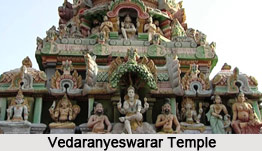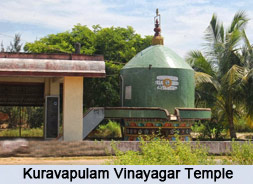 Vedaranyeswarar Temple stands in the Vedaranyam town of the south Indian state Tamil Nadu. It is a significant Hindu religious refuge dedicated to Lord Shiva. This temple forms a part of the string of temples constructed along the banks of Kaveri River by Aditya Chola to mark his victory in the Tirupurambiyam battle. It houses many inscriptions belonging to the Chola period. The maintenance and administration of the temple is looked after by the Hindu Religious and Endowment Board of the Government of Tamil Nadu.
Vedaranyeswarar Temple stands in the Vedaranyam town of the south Indian state Tamil Nadu. It is a significant Hindu religious refuge dedicated to Lord Shiva. This temple forms a part of the string of temples constructed along the banks of Kaveri River by Aditya Chola to mark his victory in the Tirupurambiyam battle. It houses many inscriptions belonging to the Chola period. The maintenance and administration of the temple is looked after by the Hindu Religious and Endowment Board of the Government of Tamil Nadu.
History of Vedaranyeswarar Temple
Vedaranyeswarar Temple contains many inscriptions which unfolds several historical facts about the temple. These inscriptions belongs to the rule of Aditya Chola (871-907 CE), Rajaraja Chola I (985-1014 CE), Rajendra Chola I (1012-1044 CE) and Kulothunga Chola I (1070-1120 CE) and narrates about the various grants received by the temple. According to an inscription which dates back to Parantaka Chola, a gift of 90 sheep was given to the temple by a merchant to maintain a perpetual lamp. During the Chola reign, the place emerged as a significant centre of Shaivism. After the decline of Chola Empire, the region came under the power struggle between Pandyas and Hoysalas and during the following rule of Nayaks also the temple continued receiving the royal patronage. The town is also the birth place of a 13th-century saint, Paranjothi Munivar, who authored the book Thiruvilaiyadal Puranam.
 Deities and Architecture of Vedaranyeswarar Temple
Deities and Architecture of Vedaranyeswarar Temple
An emerald image of lingam is enshrined in Vedaranyeswarar Temple which is locally called as Maragatha lingam. The temple complex houses three outer courtyards, also called as prakarams, along with a five-tiered gateway tower, known as rajagopuram. The central shrine of the temple face towards the east direction and houses an idol of Vedaranyeswarar or Lord Shiva in the form of lingam made of granite. Granite images of other deities like Ganesha, Navagraha (nine planetary deities), Nandi and Murugan are also placed in the hall which leads to the sanctum. The walls around the sanctum of the temple are adorned with images of Lord Dakshinamurti (Shiva as the Teacher), Chandikeswarar (a saint and devotee of Shiva) and Durga. Other zones of the temple are enclosed by granite walls.
Rituals of Vedaranyeswarar Temple
The puja is done by the temple priest on regular as well as festive basis. The priests belong to the Shaiva community. Six daily rituals are hosted by the temple at different times in between 5:30 a.m. to 8 p.m. namely Ushathkalam at 5:30 a.m., Kalasanthi at 8:00 a.m., Uchikalam at 10:00 a.m., Sayarakshai at 5:00 p.m., Irandamkalam at 7:00 p.m. and Ardha Jamam at 8:00 p.m. Each of these includes four steps as Abhisheka (sacred bath), Alangaram (decoration), Naivethanam (food offering) and Deepa Aradanai (waving of lamps). The temple also celebrates three annual festivals. Brahmotsavam is the main festival of Vedaranyeswarar Temple which is attended by a plethora of devotees. Nagaswaram, a pipe instrument, and Thavil, a percussion instrument, accompany the worship. The priests chant religious instructions of the Vedas. Weekly rituals are also performed in the temple like Sukravaram on Friday, Somavaram on Monday, Pournami on full moon day, Amavasai on new moon day and Pradosham on fortnights. During the full moon days of Tamil month Adi which falls in July - August and Thai which falls in January - February, twin festivals are celebrated. These occasions allures a sea of devotees from the whole state.





















